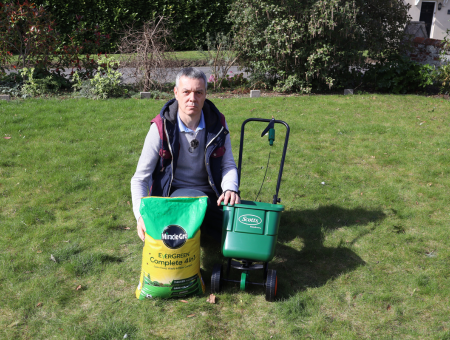
To ensure your lawn reaches its full potential, it’s important to grasp the fundamentals of lawn fertilisation. Armed with the right tools and information on the when and how of proper fertilizer application, you can set your lawn up for success throughout the growing season. By following strategic lawn fertilization schedules, not only will your lawn thrive, it can also become the envy of the neighbourhood.
Key Takeaways
- Correct fertilisation improves lawn health and appearance.
- Timing and method of application are crucial in lawn fertilisation.
- Choosing the right tools aids in effective fertilisation.
When To Fertilise
Spring
I commence my fertilising routine in early April, aligning with the first cut of the season. It’s a crucial stage for bolstering root structure which sets the tone for robust growth. At this juncture, cool-season grasses in particular are awakening from dormancy, and an organic fertiliser can support this transition. By late spring, the landscape is more vibrant, and the heightened activity necessitates a second round of nutrients to maintain lawn vigour and combat the emergence of weeds. A multi-action lawn treatment is advisable to keep unwanted growth at bay.
- Early Spring:
- Apply initial fertiliser when mowing begins.
- Opt for an organic fertiliser for gradual nutrient release.
- Mid to Late Spring:
- Supplement with a multi-action treatment to fertilise and control weeds.
Summer
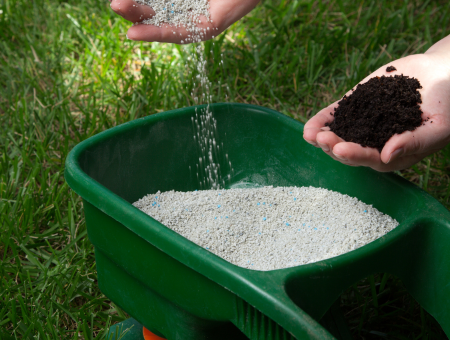
The zenith of summer brings with it the possibility of heat stress and the heightened risk of drought, although less likely in our temperate UK clime. Around mid-June to July, roughly 10-14 weeks post the spring feed, I provide my lawn with a granular feeder as a precautionary measure. Should there be a dry spell, ensuring the ground is moist prior to the application is critical, as this aids in absorption and prevents additional strain from the fertiliser’s salt content. On occasion, liquid feeders may be a suitable alternative, provided the climate remains unpredictable.
- Early to Mid-Summer:
- Fertilise 10-14 weeks after spring application, paying mind to soil moisture levels.
- Prefer granular feed, with liquid feed as an alternative in variable weather.
Autumn
As the hustle of summer wanes, autumn offers prime lawn recovery time with its temperate blend of warm days and cool nights. My calendar earmarks late August to September for this fertilising phase, coinciding with the onset of the rainy season. This period’s nurturing conditions are crucial for grass, particularly for cold-season varieties as they prepare for winter hardiness. Come late October, just before the cold fully sets in, I administer a final feed. This boosts root strength and enables the grass to stockpile nitrogen, fostering a dense and healthy lawn come the following spring.
- Early Autumn:
- Start autumn feeding as the rain becomes consistent.
- Late Autumn:
- Conclude with a pre-winter nourishment to enhance winter hardiness and nutrient storage.
How To Use Fertiliser Properly
Application Rates

I find it prudent to apply half the recommended rate on the fertiliser bag for better coverage and to prevent over-application. I first cover the perimeter of the lawn, then fill in the centre, applying fertiliser in straight lines in one direction, and then perpendicular to the first for the second half. If needed, I adjust the amount and supplement with liquid fertiliser, but caution is key to avoid fertiliser burn and promote thatch.
Wet & Dry Conditions
Adjusting fertiliser application to weather conditions is crucial. In wet conditions, I lean towards the higher end of the application scale as growth is usually robust, while in drier but moist conditions, I apply conservatively.
Know Your Numbers
Understanding the numbers on fertiliser bags is essential: they represent the percentages of Nitrogen, Phosphorus, and Potassium. I ensure a lawn soil test is done to avoid over-applying any of these nutrients. An excessive pH level can be corrected by applying lime, for which I recommend further reading about the best time for this practice.
Granules Or Liquid?
Granules are my preference due to their ease of application and consistent coverage. They hold an advantage in shelf life over liquids and eliminate the concern of equipment alteration from granules to liquid applications. When filling the lawn spreader, I do it on a hard surface to avoid spillage and potential grass burn.
Organic Or Synthetic Fertiliser?
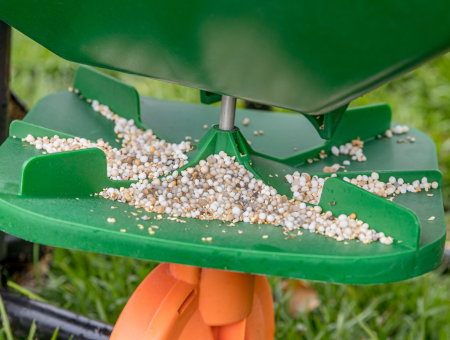
My choice leans towards organic fertilisers despite their higher cost. Their advantages include being chemical-free, longer-lasting through slow nutrient release, and supporting the growth of beneficial soil organisms. They are safe for children and pets, reduce weed and moss growth, and some include grass seed to help renew the lawn and fill bare patches.
After You Fertilised Your Lawn
Once I’ve applied fertiliser to my lawn, I make it a point not to mow for the subsequent 5 to 6 days. It is essential to allow the nutrients to integrate fully into the soil and grass roots. Here are some key points to consider post-fertilisation:
- Pet and Child Safety: I ensure the fertiliser I use is suitable around pets and children. Most options available are safe, but organic varieties guarantee 100% safety. It’s crucial to read labels carefully, especially when using chemical-based products.
- Post-Treatment Care: For granular fertilisers, I keep pets and children off the lawn until I’ve watered the granules in and they have dissolved into the soil.
It’s also important to monitor the lawn for signs of stress or damage, such as scorch marks or the presence of pests. After a heavy rain or storm, checking for runoff into storm drains is advisable, as well as assessing for water-induced issues like pink or gray snow mold. Frequent foot traffic can compound stress on a freshly fertilised lawn, so I recommend limiting it.
Regularly watching out for broadleaf weeds such as dandelions is a practice I follow, as a healthy, well-fertilised lawn can minimise their presence. Weed control measures should complement fertilisation to maintain a vigorous lawn.
Tools
Rotary Spreader
I find that using a rotary spreader greatly enhances the efficiency of fertilising my lawn. This device is akin to a bucket with a rotary disc at the base, flinging granules in an arc, covering a large area quickly. Many rotary spreaders boast variable settings and adjustable handles, which contribute to ease of use and comfort, especially for expansive lawns. It’s important to reserve the use of this spreader for fertiliser or grass seed.
Best Selling Rotary Spreaders
| # | Preview | Product | Price | |
|---|---|---|---|---|
| 1 |
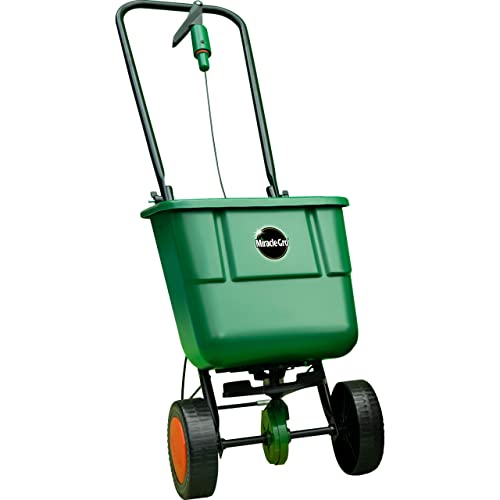
|
Miracle-Gro Rotary Lawn Seed Spreader | £58.89 £55.67 | Check Price on Amazon |
| 2 |

|
EverGreen Scotts EasyGreen Rotary spreader, Grass and Lawn Seed... | £59.20 £57.40 | Check Price on Amazon |
| 3 |

|
Defenders All-Seasons Multi-Purpose Rotary Spreader - Green |
£13.99 |
Check Price on Amazon |
Last update on 2024-03-26 / Affiliate links / Images from Amazon Product Advertising API
Drop Spreader
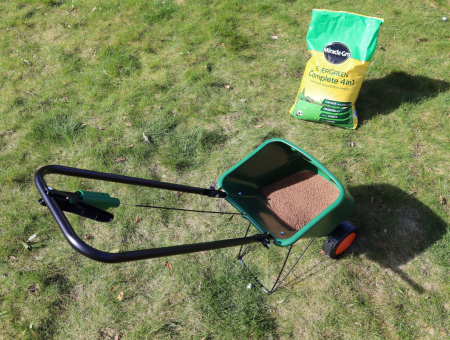
My experience with the drop spreader is that it provides meticulous control over where product falls – releasing through holes directly beneath the hopper. I’ve noted its popularity for applying not only fertiliser but also weed treatments and lawn sand. While precision is a hallmark, operating it requires care to avoid striping.
Drop spreaders have graduated settings to adjust the release rate and an on/off switch that boosts convenience. These spreaders are best suited for uniform lawns free of sharp turns.
Hand Held Spreaders
Despite being less common, I value the handheld spreader for its precision and ease. It resembles the rotary spreader, only smaller and manually operated. Whether slung over my shoulder or held in the palm, it allows for meticulous application and is an economical choice for smaller areas. Storing this compact tool is also remarkably straightforward.
Spreader Pack
If I’m after simplicity, I might opt for a spreader pack found in garden centres. They are straightforward – open the spout and stroll around to distribute the fertiliser. While they’re convenient and light, the recurrent cost and risk of uneven application are worth considering when using these pre-filled spreaders.
Which Should You Use?
In my opinion, for those looking after their home lawns, rotary spreaders are preferable. These gadgets spread the granules further apart, reducing the risk of stripes and patchy growth. The ease of use combined with cost-effectiveness makes the rotary spreader a smart investment for effective lawn care.
Conclusion
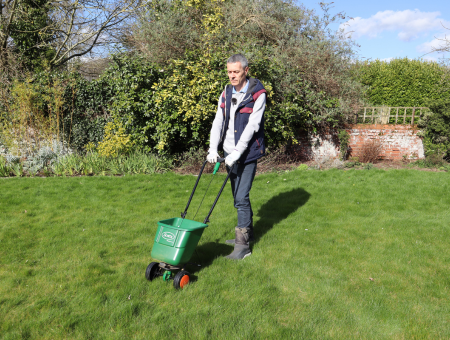
After meticulously analysing various lawn fertilisation strategies and testing a multitude of lawn mowers, I’ve uncovered that optimal lawn care requires strategic fertiliser application—a practice best executed by segmenting treatment across the year. Applying fertiliser four times annually aligns the nutrient supply with your lawn’s requirements, whilst adjusting for changing climatic conditions.
Here’s a seasonal fertilising guide for your reference:
- Spring: Kickstart your lawn’s growth with a balanced feed.
- Summer: Employ a fertiliser capable of withstanding dry conditions.
- Autumn: Prepare your lawn for winter with a fertiliser that strengthens roots.
- Winter: Use a product designed to sustain the lawn through the cold, like those reviewed here.
Selecting the perfect lawn mower further accentuates the quality of your lawn. In my reviews of various mowers, from the efficiency of robotic mowers to the power of petrol ones, I’ve identified top performers in each category. For example, the best electric mowers for medium-sized lawns are found in the list I compiled here, ensuring you have access to reliable equipment recommendations.
My decade-plus experience with garden power tools has been instrumental in shaping my ability to discern what sets a high-quality mower apart. Whether you’re in the market for a battery-powered cordless, a robust electric, a traditional petrol, or an innovative robotic mower, my insights are crafted to simplify your decision-making process for an impeccably maintained lawn.
In summary, the key to a pristine lawn lies not just in the timing and type of fertilisation but also in the consistent upkeep with a suitable lawn mower. Invest in both, and you’ll be rewarded with a lush, healthy lawn that’s the envy of the neighbourhood.
Frequently Asked Questions
What is the ideal time of year to begin fertilising my lawn?
- Spring: I start fertilising in early spring once the frost has cleared. This helps wake the grass up after dormancy and provides a nutrient boost for growth.
- Seasonal Tips: Fertilising can be adjusted based on the region and grass type, but generally, the period from March to April is suitable.
How can I choose the most effective fertiliser for improving grass health and vigour?
- Soil Testing: I conduct a soil test to determine nutrient deficiencies before selecting a fertiliser.
- NPK Ratios: I look for fertilisers with the right Nitrogen (N), Phosphorus (P), and Potassium (K) ratio for my lawn needs.
- Release Type: I decide between slow-release or fast-acting fertilisers based on my lawn’s requirements and my maintenance routine.
How frequently should I apply fertiliser to maintain optimal lawn condition?
- Guideline Table:
Lawn Type Application Frequency Cool-season grass Every 6-8 weeks during active growth Warm-season grass Every 4-6 weeks during peak growing season General Recommendation 4 times a year, at the start of each season - Monitoring: I monitor my lawn’s response and adjust the frequency as required.
Can you explain the benefits of using liquid fertiliser compared to granular types on lawns?
- Absorption: Liquid fertilisers are absorbed quickly, which means I can see results faster.
- Application: I find it easier to apply evenly, reducing the risk of over or under-fertilising certain areas.
- Versatility: Liquid options can be mixed with other treatments, saving me time.
What are the recommended steps for feeding a lawn during the autumn to prepare for winter?
- Late Autumn Feed: I switch to a fertiliser high in Potassium to help the lawn resist frost and disease.
- Aeration: Before feeding, aerating the soil ensures better nutrient absorption.
- Full Coverage: I ensure even distribution to prepare the lawn for the colder months.
What is the most suitable approach to treat patchy grass areas with fertiliser?
- Spot Treatment: I apply a higher concentration of fertiliser to the affected areas to boost growth.
- Overseeding: After fertilising, I often overseed patchy areas to encourage new growth.
- Consistency: Regular feeding and maintenance are key to preventing future patchiness.
As a seasoned expert in the field of garden power tools, I have dedicated over a decade to working with and reviewing a wide variety of lawn mowers. My extensive experience has allowed me to gain a deep understanding of the benefits and limitations of different types of mowers and garden tools.
Over the years, I have honed my skills in writing informative articles and creating helpful videos for various blogs and publications. This has given me the ability to not only recognise what makes a good lawn mower, but also to help you choose the perfect garden tool for your specific needs and requirements.
With my wealth of knowledge and expertise, I am confident that I can provide you with valuable insights and recommendations when it comes to selecting the right lawn mower for your lawn. So, whether you're looking for a battery cordless, electric, petrol, or robotic mower, you can trust in my expertise to guide you towards the best option for your garden.

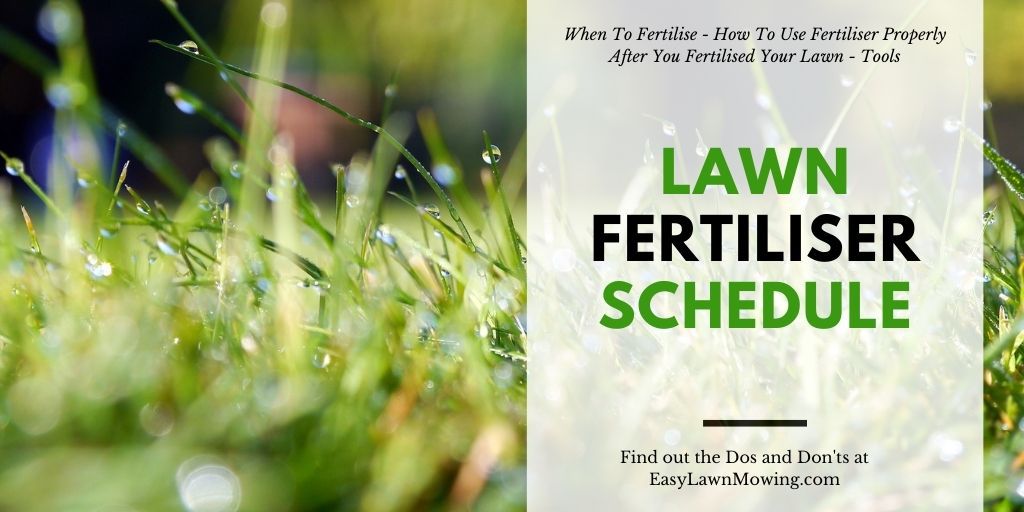






hi, your one post (the one mentioned here) is incredible as it covers the dos and donts for the whole year and also what all to use and not use as well.
the section, “know your number” and two sections before that were very informative and gave the technical details.
Brilliant I’m glad you liked it!
Thanks for the comment and if you want to have a read of more of my posts then head over to my blog. I’ve wrote about a bunch of other subjects regarding lawn care so I know you’ll love it :-)
Great article Mark for the layman! I always have trouble with my lawn. I see you recommend a good spreader to broadcast your fertilizer. This is the first year that I have considered using a fertilizer on my lawn. I tried it once and burned the yard bad. I think I will take your advice and use granules over liquids. Would you ever recommend a hand spreader?
Glad you enjoyed it Mike, yeah totally a hand spreader should be fine. They might not spread as wide as a broadcast but I’m sure they’ll just as good a job. Just make sure you don’t overlap too much otherwise you could end up burning the grass again.
And yeah using granules will be much easier to use than liquid.
Thanks for the comment and if you have any questions then please let me know :-)